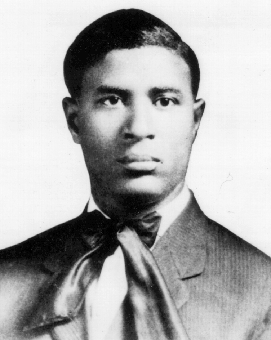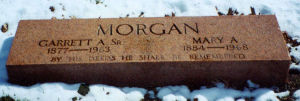Garrett Morgan
Garrett Augustus Morgan, Sr., (1877-1963) was an African American inventor who originated a respiratory protective hood, invented a variety of hair-straightening preparations, and patented a type of traffic light signal. He is renowned for a heroic rescue in which he used his hood to save workers trapped in a tunnel system filled with fumes.
Life and career
Garrett A. Morgan was born on March 4, 1877 in Paris, Kentucky to former slaves, Sydney Morgan and Elizabeth (Reed) Morgan, and seventh of eleven children. He spent his childhood attending school and working with his brothers and sisters on the family farm. When he was fourteen, he moved north to Cincinnati, Ohio, in search of employment.[1]
Morgan spent most of his teenage years working as a handyman for a wealthy Cincinnati landowner. Like many African-Americans of his day, Morgan had to quit school at a young age, in order to work. However, the teenaged Morgan hired his own tutor, and continued his studies while living in Cincinnati. As a teenager, he was inspired by Lewis Latimer.
In 1895, Morgan moved to Cleveland, Ohio, where he worked as a sewing machine repairman for a clothing manufacturer. He married Madge Nelson in 1896, and they divorced in 1898. News of his skill at fixing things and experimenting spread quickly throughout Cleveland.
In 1907, Morgan opened his own sewing machine and repair shop. It was the first of several businesses he would own. In 1909, he expanded his business to include a tailoring shop. The company made coats, suits, dresses, etc. - all sewn with equipment that Morgan himself had made. Morgan experimented with a liquid that gave a sewing machine needles a high polish and prevented the needle from scorching fabric, as it sewed. Accidentally, Morgan discovered that this liquid not only straightened fabric but also hair. He made the liquid into a cream and began the G.A. Morgan Hair Refining Company. Morgan also made a black hair oil dye and a curved-tooth Iron comb in 1910, to straighten hair.
In 1908, Morgan helped found the Cleveland Association of Colored Men. That same year, he married Mary Anne Hassek and together they had three sons.
In 1920, Morgan moved into the newspaper business when he established The Cleveland Call. As the years passed, he became a prosperous and widely respected business man, and he was able to purchase a home and an automobile. He is reported to have been the first African American to own an automobile.
Inventions
Safety Hood
Morgan invented his safety hood and smoke protector after hearing about the Triangle Shirtwaist Factory fire. He was able to sell his invention around the country however, in many instances, he would have a white partner take credit as the inventor in order to further sell his product. His invention became known nationally when he used it to save several men from a tunnel explosion under Lake Erie. Garrett was awarded a gold Medal of Bravery by prominent citizens of Cleveland, but his nomination for the Carnegie Medal was denied, in large part because of his race. Efforts by Morgan and his supporters over the years to correct this injustice have not, so far, been successful. Nevertheless. Morgan's invention won gold medals from the International Association of Fire Chiefs and the International Exposition of Sanitation and Safety.[2]
It has often been claimed that Morgan invented the first "gas mask", however, the first practical gas mask was invented by Scottish chemist John Stenhouse in 1854. A precursor to the "gas mask" had been invented by Lewis Haslett in 1847 and granted US Patent ##6529 in 1859. Numerous other inventors, including, Charles Anthony Deane (1823), John Tyndall (1871), Samuel Barton (1874), George Neally (1877), Henry Fleuss (1878), before Morgan's invention that was patented in 1914 (US Patent numbers 1090936 and 1113675), but does not diminish Morgan's heroism in using his mask to rescue the men trapped in the tunnel explosion, which was undertaken at great personal risk. In fact, because the Safety Hood was not especially well-suited to protect its wearer from the underground gasses in the Lake Erie explosion, Morgan may have suffered from exposure to these gasses; late in life he blamed his health problems on this experience, and unsuccessfully pleaded with the City of Cleveland for compensation.
The Garrett Morgan traffic signal
It was Morgan's experience while driving along the streets of Cleveland that led to his invention of the traffic signal.
The first American-made automobiles were introduced to U.S. consumers not long after the turn of the century. It was not uncommon for bicycles, animal-powered wagons and new gasoline-powered motor vehicles to share the same streets and roadways with pedestrians. According to tradition, it was after witnessing a collision between an automobile and a horse-drawn carriage that Morgan became convinced that something more needed be done to improve automobile safety.
The Morgan traffic signal was a T-shaped pole unit that featured three hand-cranked positions: Stop, Go and an all-directional stop position. This third position halted traffic in all directions to allow pedestrians to cross streets more safely. It was an improvement in some ways from earlier mechanical signals, but it was not by any means the first traffic signal. The first known traffic signal appeared in London in 1868 near the Houses of Parliament. Designed by JP Knight, it featured two semaphore arms and two gas lamps. The earliest electric traffic lights include Lester Wire's two-color version set up in Salt Lake City circa 1912, James Hoge's system (US patent #1,251,666) installed in Cleveland by the American Traffic Signal Company in 1914, and William Potts' 4-way red-yellow-green lights introduced in Detroit beginning in 1920. New York City traffic towers began flashing three-color signals also in 1920.
Garrett Morgan's cross-shaped, crank-operated semaphore was not among the first half-hundred patented traffic signals, nor was it "automatic" as is sometimes claimed, nor did it play any part in the evolution of the modern traffic light. Its one advantage over others of its type was the ability to operate it from a distance using a mechanical linkage. Another widely-repeated story, that Morgan sold the rights to his traffic signal to the General Electric Corporation for $40,000, cannot be verified "either in the US patent assignment records at the National Archives, or in the GE historical business records at the Schenectady (New York) Museum, or in Morgan's legal and business papers at the Western Reserve Historical Society in Cleveland."[3]
Awards and recognitions
At the Emancipation Centennial Celebration in Chicago, Illinois in August, 1963, Morgan was nationally recognized. Although in ill-health, and nearly blind, he continued to work on his inventions; one of his last was a self-extinguishing cigarette, which employed a small plastic pellet filled with water, placed just before the filter. Shortly before his death, in 1963, Morgan was awarded a citation for his traffic signal by the United States Government.
In Prince George's County, Maryland, Garrett A. Morgan Boulevard and the adjacent Washington Metro's Morgan Boulevard Station are named in his honor. In 1991, the Division Avenue Water Works in Cleveland was renamed the Garrett Morgan Treatment Plant. Also in his honor is the Garrett A. Morgan Cleveland School of Science in Cleveland, Ohio.
Morgan was an honorary member of Alpha Phi Alpha, the oldest intercollegiate Greek-letter fraternity established for African Americans.
Garrett A. Morgan, Sr. died on August 27, 1963, at the age of 86 and was buried at Lake View Cemetery in Cleveland, Ohio.
References
External links
- http://www.pbs.org/wgbh/theymadeamerica/whomade/morgan_hi.html
- http://www.africanamericans.com/GarrettMorgan.htm
- http://education.dot.gov/aboutmorgan.html
- The Encyclopedia of Cleveland History - Waterworks Disasters
- Images from Morgan's patents
- Early US traffic signal patents
- The first traffic signals in Cleveland
- The development of U.S. Army gas masks during World War I
- Who Invented the gas mask?
- The Encyclopedia of Cleveland History - biography


